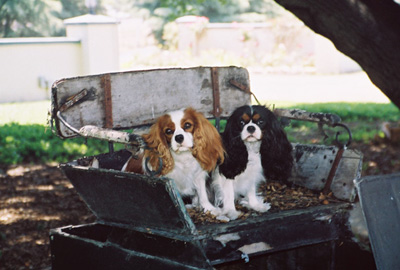Breed Information
 Early History
Early History
Court life in Europe embraced toy spaniels as early as the fifteenth century. Referred to as "comforter spaniels" , these dogs were bred to snuggle in their owners laps and beds to provide companionship and warmth. They were immortalized in the art of Van Dyck, Titian, Stubbs, Landseer, and Gainsborough. That said, their association with the royal families of England has irrevocably linked their evolution to "that sceptered isle." Mary Queen of Scots and Charles I, Charles II, and the Duke and Duchess of Marlborough—all helped to popularize this charming little dog. However, over the centuries the Cavalier was temporarily supplanted in public affection by the shorter muzzled, domed-headed King Charles Spaniel (a related but separate breed), and the Cavalier's ultimate survival was in some doubt.
In 1925, an American, Roswell Eldridge, became intrigued by the old Cavalier type as seen in many paintings and statues. He offered £25 at the UK Crufts Dog Show in 1926 for winners of Cavalier classes. This was a substantial amount in those times, and breeders accepted the challenge with alacrity. After considerable effort, the Cavalier was saved for posterity, and in 1928 the UK Cavalier King Charles Spaniel Club was founded. The first Cavaliers were sent to the USA in 1952. The breed has become increasingly popular, but it was not until 1996 that the Cavalier achieved full recognition by the AKC as the 140th AKC breed. The American Cavalier King Charles Spaniel Club was established in 1993 and remains the parent club for the Cavalier in this country.
Health
The Cavalier King Charles Spaniel has become increasingly more popular over the last decade. Cavaliers are a charming breed and ever so easy too live with, so this increased demand is understandable, but from some standpoints regrettable.
One of the problems associated with this new found popularity is the emergence of ”backyard breeders” who produce litter after litter of puppies purely for profit. While "backyard bred" dogs are usually sold to unsuspecting consumers through newspaper and online advertisements, commercially bred puppies (aka “Puppy–Mill” puppies) are being sold in Pet Stores and sometimes through brokers via newspaper ads and online websites.
The problem common to both of these resources is that customarily, there is no health testing of the dogs they breed from and in most cases little there is very limited knowledge of, or focus on, the breed standard, conformation and the major health problems concerning the breed. Obviously this doesn't make for well thought out breedings, nor does it typically result in good examples of the the breed as far as type or, more importantly to potential pet owners, health. Another factor is that, all too often, the dogs in both "back yard" and commercial situations are not well socialized and are kept in sub-standard conditions. It is also important to remember that virtually ALL pet store dogs, regardless of breed, come from commercial breeders ... in the case of Cavaliers, both the CKCSC, USA and the American Cavalier King Charles Spaniel Club breeders (**not to be confused with AKC (American Kennel Club) which is a registering body only**) strictly prohibit members from selling puppies to pet stores.
When you are looking for a Cavalier, it is imperative to interview the breeder and find out if the sire and dam of the puppy have been tested for heart, eyes, patellas and hips with the first two tests (hearts & eyes) being conducted by board certified specialists (Canine Cardiologist/ Ophthalmologist) Patellas (can be done by a regular vet) and hips should be x-rayed and sent to the OFA (Orthopedic Foundation For Animals) to be read by and recorded with the OFA. Note that some breeders elect to record all of their health testing with the OFA, while others choose to maintain their own health records and only use OFA to read and record hip evaluations. Regardless of how breeders handle the management of their health testing, they should be able to provide you with copies of the health testing from the various specialists and veterinarians used to conduct them. One of the best pieces of advice to prospective puppy buyers we can offer is to buy the breeder first (meaning their philosophy and their practices) and a puppy second.
There are a number of excellent web sites which deal with health issues and we recommend the following:
- For an excellent article giving an overview of common Cavalier health problems visit http://www.cavalierhealth.info
- For a general understanding of Cavalier health visit http://www.aboutcavalierhealth.com
- This site includes a forum for discussion on health issues http://www.cavalierhealth.co.uk